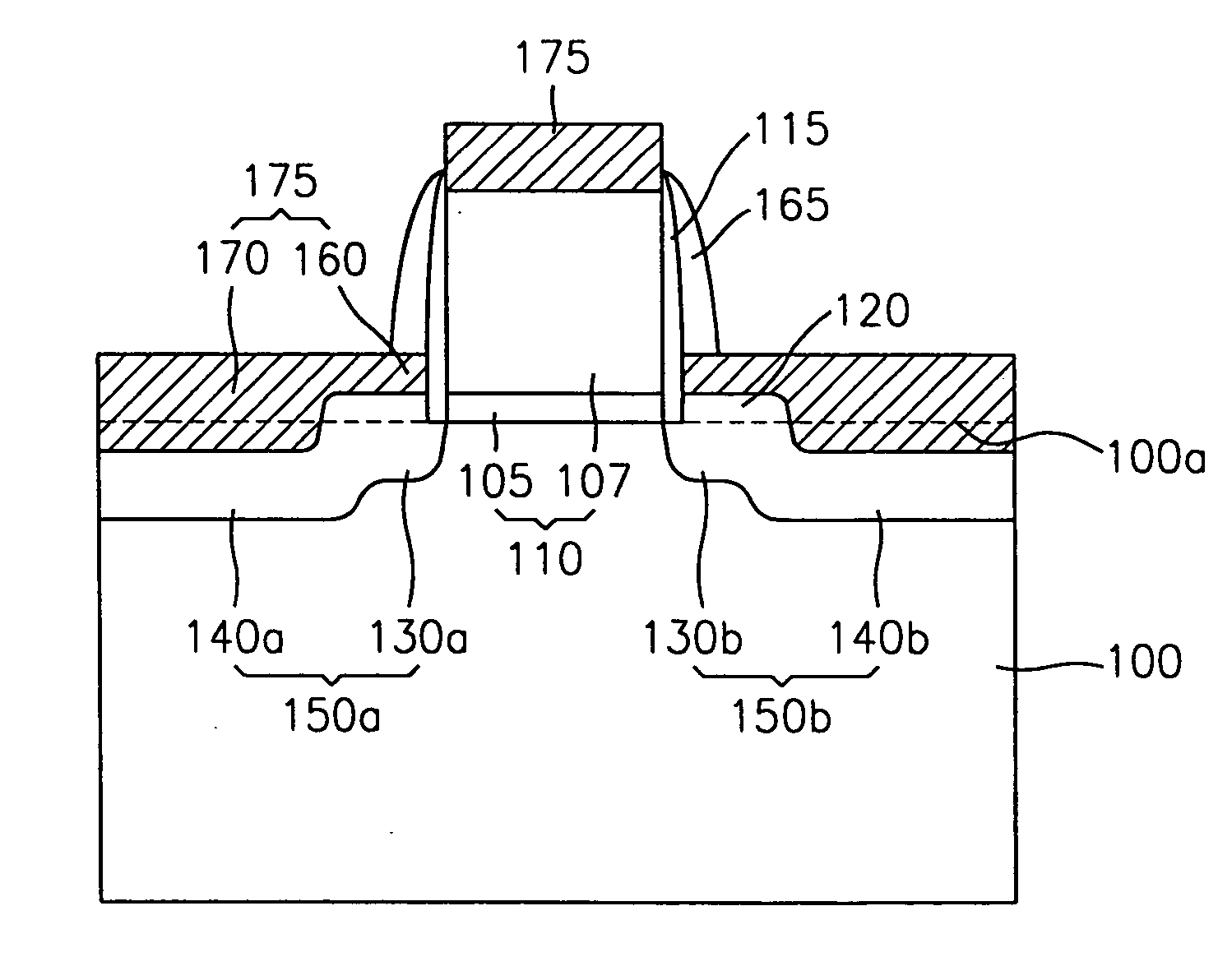Highly integrated semiconductor device with silicide layer that secures contact margin and method of manufacturing the same
a technology of contact margin and semiconductor device, which is applied in the direction of semiconductor device, electrical apparatus, transistor, etc., can solve the problems of reducing the operating speed of the semiconductor device, reducing the resistance, and causing misalignmen
- Summary
- Abstract
- Description
- Claims
- Application Information
AI Technical Summary
Benefits of technology
Problems solved by technology
Method used
Image
Examples
first embodiment
[0036]FIG. 3 is a cross-sectional view of a highly integrated semiconductor device according to the present invention, and FIGS. 4A through 4D are cross-sectional views illustrating a method of manufacturing the highly integrated semiconductor device of FIG. 3.
[0037] Referring to FIG. 3, a gate electrode 110 is formed on a semiconductor substrate 100. The semiconductor substrate 100 may be, for example, a silicon substrate or a silicon-germanium substrate. The gate electrode 110 includes a gate insulating layer 105 and a polysilicon layer 107. The gate electrode 110 is recessed a predetermined thickness into the semiconductor substrate 100. That is, the surface of the semiconductor substrate 100 on both sides of the gate electrode 110 is elevated to a predetermined thickness so as to overlap the sidewalls of the gate electrode 110. Predetermined portions of the semiconductor substrate 100 that partially overlap the sidewalls of the gate electrode 110 may be a selective epitaxial gro...
second embodiment
[0054]FIG. 6 is a cross-sectional view of a highly integrated semiconductor device according to the present invention.
[0055] In the same manner as described in the first embodiment, the silicide layer 160 is formed on the gate electrode 110, the source region 150a, and the drain region 150b. Next, a self-aligned spacer 165 is formed along the sidewalls of the offset spacer 115 that is formed along the sidewalls of the gate electrode 110. The self-aligned spacer 165 may be a silicon nitride layer, and may be thicker than the offset spacer 115.
[0056] Since a self-aligned contact (SAC) pad (not shown) can be formed on the source region 150a and the drain region 150b on the sides of the gate electrode 110 by virtue of the self-aligned spacer 165, the highly integrated semiconductor device according to the second embodiment of the present invention can be used as a transistor in a dynamic random access memory (DRAM) cell.
third embodiment
[0057]FIG. 7 is a cross-sectional view of a highly integrated semiconductor device according to the present invention.
[0058] The highly integrated semiconductor device can be formed on a silicon-on-insulator (SOI) substrate instead of the semiconductor substrate 100 made of silicon. Referring to FIG. 7, an SOI substrate 200 is prepared. The SOI substrate 200 includes a base substrate 210, a silicon oxide film-buried layer 220, and a silicon layer. 230. The SOI substrate 200 can be formed by bonding two wafers or implanting oxygen into a wafer using ion implantation.
[0059] Next, the gate electrode 110 and the source and drain regions 150a and 150b are sequentially formed in the SOI substrate 200 in the same manner as described in the first embodiment of the present invention. Since the silicon layer 230 of the SOI substrate 200 has the same properties as the semiconductor substrate 100 of the first embodiment of the present invention, the highly integrated semiconductor device can b...
PUM
 Login to View More
Login to View More Abstract
Description
Claims
Application Information
 Login to View More
Login to View More - Generate Ideas
- Intellectual Property
- Life Sciences
- Materials
- Tech Scout
- Unparalleled Data Quality
- Higher Quality Content
- 60% Fewer Hallucinations
Browse by: Latest US Patents, China's latest patents, Technical Efficacy Thesaurus, Application Domain, Technology Topic, Popular Technical Reports.
© 2025 PatSnap. All rights reserved.Legal|Privacy policy|Modern Slavery Act Transparency Statement|Sitemap|About US| Contact US: help@patsnap.com



